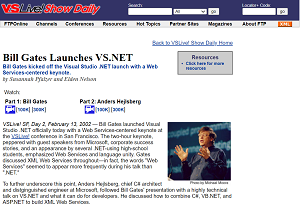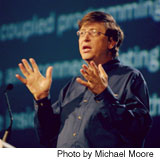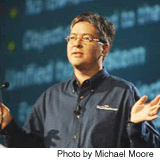News
The Birth of .NET: Bill Gates Launches 'VS.NET' at Our VSLive! Conference
Microsoft this week celebrated the 20th anniversary of .NET, which was debuted by none other than Bill Gates at the 2002 VSLive! tech conference in San Francisco, associated with Visual Studio Magazine.
"Today marks 20 years since Visual Studio .NET launched and the first version of the .NET platform was released (or should I say, unleashed) to the world," said a Feb. 13 announcement post by Microsoft's Beth Massi, who added, "We're celebrating all month long."
Well, since it all kind of began right here, in a manner of speaking, we though we'd take part in this month-long celebration by sharing the article that announced .NET to the world, though it was introduced as VS.NET by Gates. Among the dignitaries appearing during the keynote address was Anders Hejlsberg, the chief designer of C# who was also instrumental in helping to create .NET.
 [Click on image for larger view.] Bill Gates Announcing VS.NET (source: Us).
[Click on image for larger view.] Bill Gates Announcing VS.NET (source: Us).
So here's the article reproduced as best we could. Note that we updated the original links in the text, which have long ceased to point to what they were supposed to, victims of 20 years of internet evolution:
Bill Gates Launches VS.NET
Bill Gates kicked off the Visual Studio .NET launch with a Web Services-centered keynote.
by Susannah Pfalzer and Elden Nelson
 VSLive! SF, Day 2, February 13, 2002 — Bill Gates launched Visual Studio .NET officially today with a Web Services-centered keynote at the VSLive! conference in San Francisco. The two-hour keynote, peppered with guest speakers from Microsoft, corporate success stories, and an appearance by several .NET-using high-school students, emphasized Web Services and language unity. Gates discussed XML Web Services throughout—in fact, the words "Web Services" seemed to appear more frequently during his talk than ".NET."
VSLive! SF, Day 2, February 13, 2002 — Bill Gates launched Visual Studio .NET officially today with a Web Services-centered keynote at the VSLive! conference in San Francisco. The two-hour keynote, peppered with guest speakers from Microsoft, corporate success stories, and an appearance by several .NET-using high-school students, emphasized Web Services and language unity. Gates discussed XML Web Services throughout—in fact, the words "Web Services" seemed to appear more frequently during his talk than ".NET."
To further underscore this point, Anders Hejlsberg, chief C# architect and distginguished engineer at Microsoft, followed Bill Gates' presentation with a highly technical talk on VS.NET and what it can do for developers. He discussed how to combine C#, VB.NET, and ASP.NET to build XML Web Services.
Gates began with an overview of computing milestones. Commenting that "many big paradigm shifts have driven the software industry to a new level," he offered a timeline that spanned from "Big Iron," to the PC, the advent of the GUI, the Web, and finally—as the next milestone—XML Web Services. Touting XML Web Services as "a new approach to programming," Gates underscored throughout the keynote that Web Services is the next generation of computing. Gates called Web Services "the underpinning of how business is done … This is a key initiative." Adding to the keynote's partnership and compatibility theme, Gates announced the founding of the Web Services Interoperability Organization.
Gates tied .NET in with Web Services as the first Web Services tool, and called Web Services applications key to productivity improvements. Demonstrating a shift from the traditional client/server paradigm, Gates added services to that duo, including Web Services and .NET My Services. He said, "The entire Microsoft research and development budget is focused around these goals"—to the tune of $5 billion a year.
Gates called the introduction of .NET an "industry milestone," and provided a brief overview of the languages .NET comprises. Tellingly, he didn't discuss language specifics for either Visual Basic .NET or C#, and demos throughout the keynote used VB.NET for some, C# for others. He also stressed the more than 20 languages—including COBOL and Java—that can work within the .NET integrated development environment (IDE) with one framework, and one debugger. Gates appeared to promise .NET as a language equalizer—within which many languages can be used.
Customer .NET success stories, in which both rapid development and mobile application development was a major theme, emphasized .NET's ease of use, as did an "Iron Developer" contest, in which InterKnowlogy's Tim Huckaby and Clarity Consulting's Jon Rauschenberger developed .NET apps in an hour. Rational's Grady Booch demonstrated modeling and patterns in the context of .NET, and one of the keynote's most popular elements was the introduction of several student developers from Danville, Calif.'s Monte Vista High School, who built a .NET application in five weeks.
Gates mentioned security, fault tolerance, and scalability, although with few implementation details. He noted that Web Services need to be able to run 24 hours a day, and emphasized the need to trust Web Services as we would telephones or the electrical system. Presumably, in Microsoft's view, Web Services will become as ubiquitous in the future as these two staples of modern society.
 Next to present was Anders Hejlsberg, Distinguished Engineer in the Developer Division at Microsoft Corporation. He is the chief designer of the C# programming language and a key participant in the development of the .NET Framework. Previously, Anders was the architect for Visual J++ and the Windows Foundation Classes.
Next to present was Anders Hejlsberg, Distinguished Engineer in the Developer Division at Microsoft Corporation. He is the chief designer of the C# programming language and a key participant in the development of the .NET Framework. Previously, Anders was the architect for Visual J++ and the Windows Foundation Classes.
Hejlsberg focused on the benefits of Web Services using VS.NET, as well as the productivity gains developers get by using the .NET Framework.
Hejlsberg pointed out the virtues of the simplified development programmers will have using VS.NET. He noted that the low level of abstraction and difficulties of configuring and deploying COM have hurt developers. While VB added some ease of use, it required wrappers and sacrificed functionality. With the higher level of abstraction inherent in .NET, there's less low-level COM plumbing, with object orientation going clear to the core. Hejlsberg's pride was also evident in the unified type system that's part of .NET, where everything is an object, there's a single string type, and all character data is Unicode.
The highlight of Hejlsberg's address was when, from scratch, he created a Web service, consumed it from both browser and rich clients, then deployed the rich client over the Web, all in the span of 15 minutes. Regarding the issue of security, Hejlsberg pointed out that everything is protected through exceptions, so if the rich client tries to do something illegal, an exception is raised but handled gracefully and the user can continue.
Click on the links at the top of the page to view the videos of Bill Gates' and Anders Hejlsberg's presentations.
We also found the archived original article, if you'd like a taste of the 2002-era internet (albeit with missing images and broken links).
About the Author
David Ramel is an editor and writer at Converge 360.